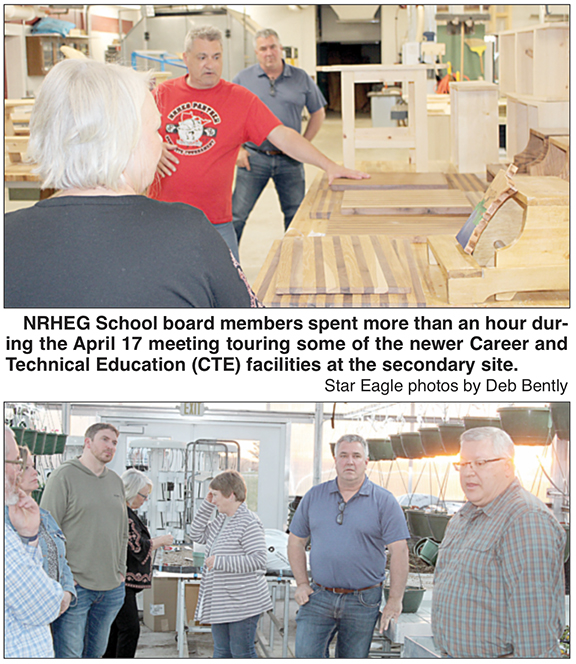 By DEB BENTLY
By DEB BENTLY
Staff Writer
NRHEG School board members spent more than an hour during the April 17 meeting touring some of the newer Career and Technical Education (CTE) facilities at the secondary site and hearing about the opportunities the facilities, finished in the fall of 2019, have opened up for students.
First on deck was “shop” teacher Brad Root, who showed board members some recently completed student projects ranging from two-seated adirondack chairs to birdhouses. He indicated the entire room, telling board members that it was once divided into four separate work areas, leading to a lack of adequate work and storage space, not to mention some potentially unsafe working conditions.
With a new space next door for engines and metal working, Root said, his students can now spread out to work individually or in groups, allowing for collaboration, one-on-one instruction, and even peer mentoring.
With the additional space and funding from various sources, including the sale of student projects, the department now has battery-powered tools which, Root said, are not only up-to-date, but much safer thanks to the absence of electrical cords–which once overlapped or even tangled when students were working in close quarters.
Root demonstrated the 12x12 foot painting cabinet which, thanks to powerful ventilation, has allowed for a significant improvement in air quality in the space. He also pointed to the “Timesaver” brand wood finisher. Root mentioned that students entering his program come from a variety of experience and income levels. He indicated dozens of boards stored in the space, revealing that they are available to students because they were acquired when the school’s wooden bleachers were disassembled.
The next stop on the tour was the welding shop. Teacher Dan Sorum indicated the space and informed board members that it was nearly identical in size to the wood shop they had just left. Thanks to the “doubled” space, he now has 15 or more workstations, some for various types of welding, as well as other advanced equipment, including plasma cutters, a plasma table, and even a laser engraver on a short-term loan from the University of Minnesota system.
Sorum told board members that the expanded space, coupled with specialized welding booths and work stations, have greatly increased safety and efficiency while allowing more students to be engaged in completing projects.
From the metals area, board members moved on to the agriculture department’s freestanding greenhouse, located to the west of the main school building. Sorum described numerous projects which have been or are being carried out thanks to the facility. Suspended throughout the greenhouse were dozens of potted plants, all being grown for the FFA plant sale set for May 12 and 13. Also growing were various vegetables, some for the upcoming sale, some for another agency which has arranged to have NRHEG students start and monitor the plants for them.
Sorum described some of the advanced features of the greenhouse, including a ventilation system which automatically monitors the temperature and opens various vents to adjust it. He commented that, even in the coldest part of winter, there are times on sunny days when the facility must open some windows to cool itself.
The final element of the evening’s tour was the family and consumer sciences (FACS) classroom. Board members were treated to four kinds of baked treats, all selected and prepared by the “ProStart” class members. Students in grades 9-12 are eligible for this course, which provides them with training and practice at preparing and serving foods according to industry-level standards.
FACS teacher Kelly Delacruz indicated her classroom, which is considerably expanded from the size of the previous FACS space; a wall was removed and two rooms consolidated into one to reach the current dimensions. The room includes industry-grade stovetops, ovens and refrigerators; cabinets and work surfaces have a stainless steel finish. Delacruz assured board members that, despite the professional appearance and intent of the space, students can also use the equipment to prepare the types of meals typically served in households. “It gives us more flexibility,” she observed. “We can prepare food and meals according to whatever standard suits our needs.”
Around its perimeter, the FACS classroom features counters with sewing machine stations. “We still teach sewing,” Delacruz said in response to a board member’s question. “My middle school students are making pillow cases right now.”
After roughly an hour of touring, board members returned to the media center where they followed through on regular monthly business.
